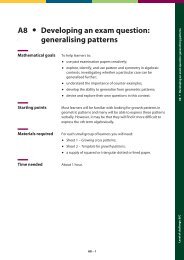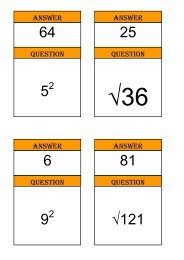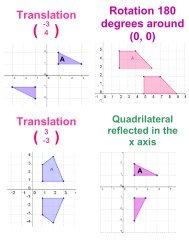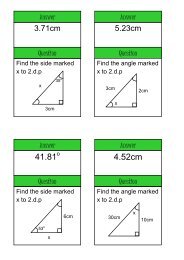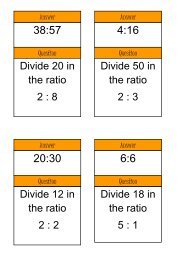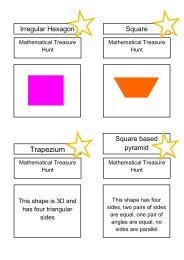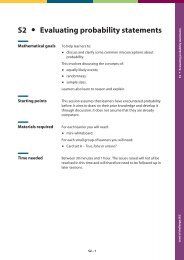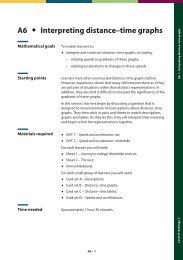Core Maths C1 Revision Notes - Mr Barton Maths
Core Maths C1 Revision Notes - Mr Barton Maths
Core Maths C1 Revision Notes - Mr Barton Maths
Create successful ePaper yourself
Turn your PDF publications into a flip-book with our unique Google optimized e-Paper software.
The discriminant b 2 – 4ac<br />
In the formula for the quadratic equation<br />
ax 2 + bx + c = 0 ⇒ x =<br />
− b ±<br />
2<br />
b − 4ac<br />
2a<br />
i) there will be two distinct real roots if b 2 – 4ac > 0<br />
ii) there will be only one real root if b 2 – 4ac = 0<br />
iii) there will be no real roots if b 2 – 4ac < 0<br />
Example: For what values of k does the equation 3x 2 – kx + 5 = 0 have<br />
i) two distinct real roots,<br />
ii) exactly one real root<br />
iii) no real roots.<br />
Solution: The discriminant b 2 – 4ac = (–k) 2 – 4 × 3 × 5 = k 2 – 60<br />
⇒ i) for two distinct real roots k 2 – 60 > 0<br />
⇒ k 2 > 60 ⇒ k < –√60, or k > +√60<br />
and ii) for only one real root k 2 – 60 = 0<br />
⇒ k = ±√60<br />
and iii) for no real roots k 2 – 60 < 0<br />
⇒ –√60 < k < +√60.<br />
Miscellaneous quadratic equations<br />
a) 2 sin 2 x – sin x – 1 = 0.<br />
Put y = sin x to give 2y 2 – y – 1 = 0<br />
⇒ (y – 1)(2y + 1) = 0 ⇒ y = 1 or y = –½<br />
⇒ sin x = 1 or –½ ⇒ x = 90°, 210° or 330° from 0° to 360°.<br />
b) 3 2x – 10 × 3 x + 9 = 0<br />
Notice that 3 2x = (3 x ) 2 and put y = 3 x to give<br />
y 2 – 10y + 9 = 0 ⇒ (y – 9)(y – 1) = 0<br />
⇒ y = 9 or y = 1<br />
⇒ 3 x = 9 or 3 x = 1 ⇒ x = 2 or x = 0.<br />
c) y – 3√y + 2 = 0. Put √y = x to give<br />
x 2 – 3x + 2 = 0 and solve to give x = 2 or 1<br />
⇒ y = x 2 = 4 or 1.<br />
<strong>C1</strong> 14/04/2013 SDB<br />
7





